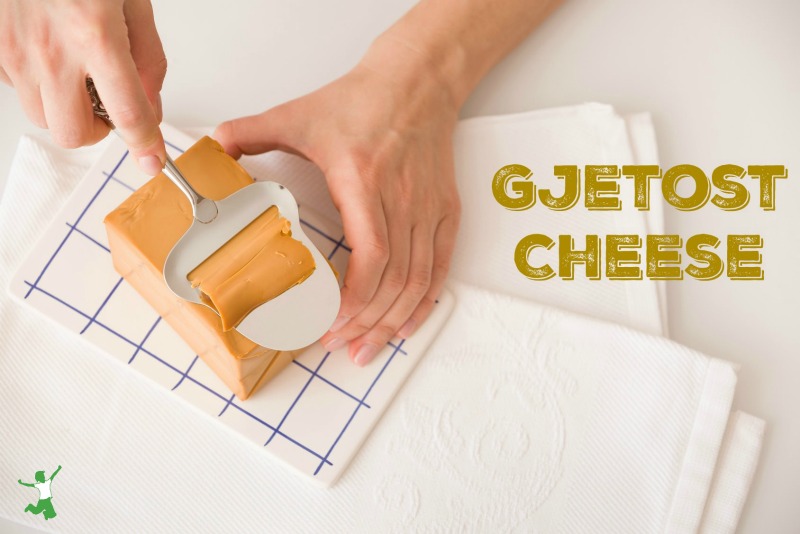Easy recipe for homemade gjetost cheese traditional to Norway that can be made with leftover liquid whey from other culinary activities.
My friend Mary recently mentioned to me that she was drowning in whey.
She had a gallon or two of raw milk that had soured and she wisely decided to allow it to naturally separate on the kitchen counter. She then strained the clabbered milk into cream cheese and whey.
The raw cream cheese could be blended with a bit of maple syrup and strawberries to make a lovely raw spread for a morning bagel, but what about all that whey?
I suggested that some of the whey could be used for fermenting probiotic loaded vegetables and fruits such as beet kvass or sauerkraut. But, Mary said she had so much, there was no chance she would use all of it for that purpose.
Help!
Homemade Gjetost Cheese
In situations like this, use the extra whey to make traditional Norwegian gjetost cheese (pronounced “yay-toast”).
This simple, healthy cheese is made by boiling down whey for a number of hours until it is reduced to a quarter or less of its original volume. When the gjetost cheese is almost ready with the whey almost boiled down, you add some cream to enhance the smoothness and flavor. The color as it boils down gets darker and darker.
Believe it or not, that is all there is to it!
Gjetost cheese tastes somewhat like cultured butter with some cheddar overtones and can be served as a sauce for pasta similar to a creamy alfredo sauce.
You can also use gjetost cheese to flavor vegetables or enhance the flavor of soups.
The idea is to boil it down to the desired consistency for the appropriate culinary use.
You may use the whey from either cow or goat milk to make your gjetost cheese. Know that if you make it from goat whey which is the traditional way to do it, it will definitely taste a bit goaty.

Homemade Gjetost Cheese Recipe
Easy recipe for homemade gjetost cheese traditional to Norway that can be made with leftover liquid whey from other culinary activities.
Ingredients
- 1/2 gallon liquid whey FRESH, not leftover from cheesemaking
- 1/2 cup cream preferably organic and grassfed
Instructions
-
Pour the whey into a large pan and bring to a low boil. Simmer uncovered for 2-3 hours stirring frequently until the whey has been reduced to the texture of thick gravy and is about 1 pint in volume.
* This is a great task to start right after breakfast and it will be done by lunchtime.
-
Stir in cream and continue to simmer stirring often until desired consistency is reached.
-
Remove from heat and let cool for a few minutes. Blend the gjetost cheese with a stick blender to enhance creaminess and serve warm immediately as a pasta sauce or pour into containers to refrigerate for later use.
-
Gjetost cheese will solidify a bit in the refrigerator and will last for about 1 month. It is delicious cold as a spread on crackers.

More Recipes for Homemade Cheese
How to Make Ricotta Cheese
Homemade Quark recipe
How to Make Whey and Cream Cheese
Cheesemaking: Common Problems and Solutions
How to Make Yogurt Cheese
Perfect Cottage Cheese








To make more sweet gjetost you mentioned that need the milk to be caramelized, is that you mean during the cooking process I hve to add the milk within the process or just cook the goat milk without have to go through the whey making process? Need some enlightment pls. Thank you
Not sure what you are referring to. This recipe uses whey and cream not milk.
You said “not the whey left from cheesemaking”. What other kind of whey is there? Do you mean not from making yogurt?
The clear liquid in yogurt or kefir is whey. There is whey in milk as well and if the milk is raw, you can clabber it and separate out the whey. https://www.thehealthyhomeeconomist.com/video-liquid-whey-and-cream-cheese/
Hello. I used whey leftover from batches of yogurt I make from pasteurized skim milk I get from the grocery store. The product I ended up with is so terribly salty, I don’t think that it is consumable. Any ideas?? I am wondering if I should try to reduce it some more because it is still very thin. I used half gallon whey and when it had reduced almost down to 1 cup or so, I added the cream.
I cannot get over the saltiness of the flavor. I’m thinking of pitching it out, but it would be a waste.
Any ideas of what I can do?
Thanks in advance!!
Thanks for the simple recipe! I can’t wait to try it. I hear it’s excellent on waffles. Use whey in place of buttermilk in your waffles, and you shouldn’t be drowning in whey anymore!
Can you put it on super high fire to make it eveporate really fast?? I can keep stirring it non stop to prevent scorching 🙂
Why shouldn’t you use whey that was the by product of making cheese? I make a simple farm cheese by heating my raw milk to 190-200F, then I put about a half a cup of apple cider vinegar in it and it makes a lovely cheese for lasagna, etc. I have plenty of whey left over and was going to try this recipe, but you specifically say NOT leftover from cheese making. Why?
i wonder the same thing because i made this out of the whey i had used from making cheese..
I made mozzeralla then with the whey heated it back to 200 degrees and got some ricotta out of it THEN put it back on the stove and made This above cheese. My only issue is it was very sour. But i assumed it was because it was unpasturized goats milk that sat in the freezer for a year. I have more on the stove right now that was milked from my goat this AM. I already made Cheese and now im making this. Its not as sour but it is still sour. so wondering if thats why… idk
It is not possible to make gjetost out of cow’s mile, or cream. Why? Because gjetost is made from goats milk, by definition. It is a Norwegian word. In Norsk, a gjet is a goat, and ost is cheese. Gjetost is goat cheese.